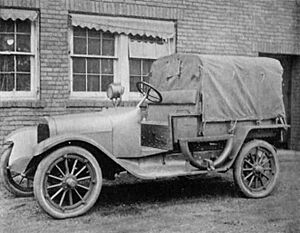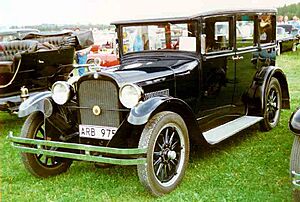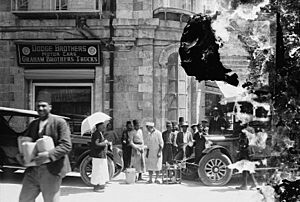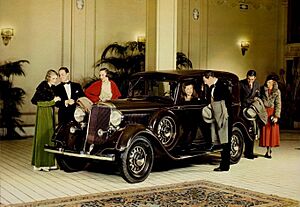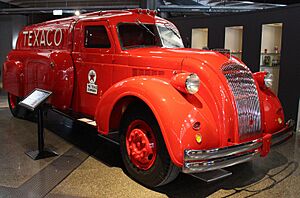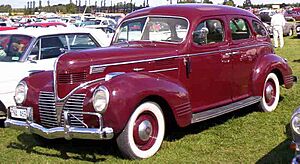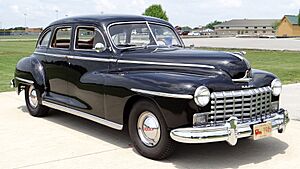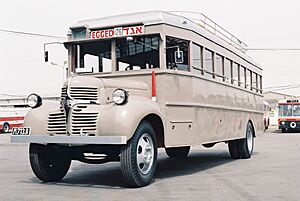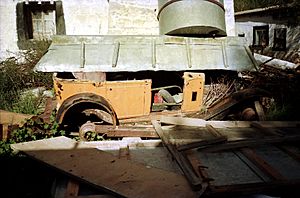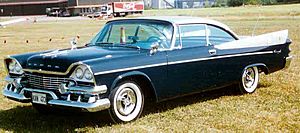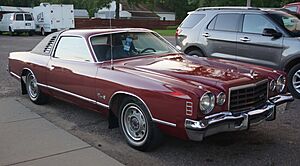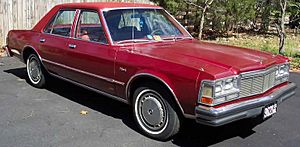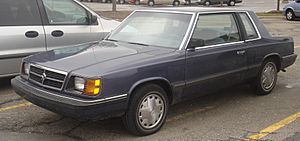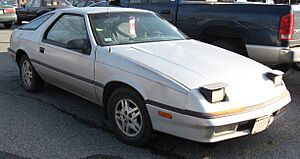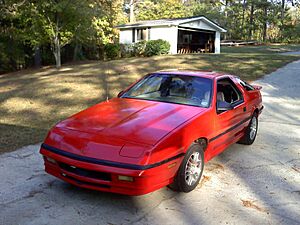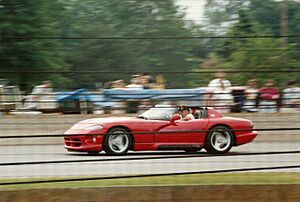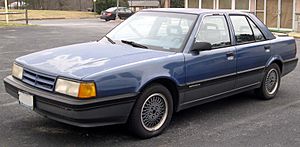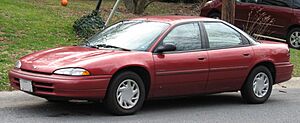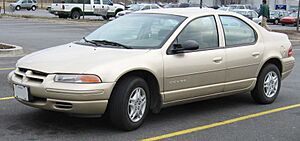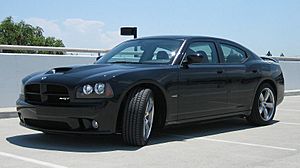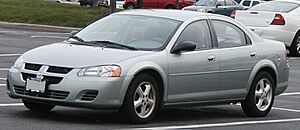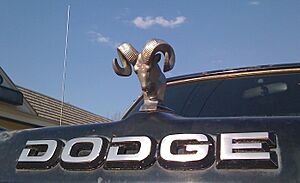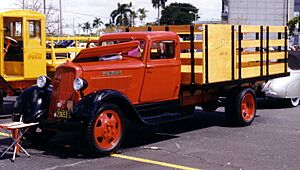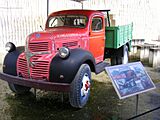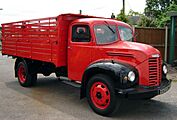Dodge facts for kids
| Private (1900–28) Division (1928–present) |
|
| Industry | Automotive |
| Fate | Acquired by Chrysler Corporation in 1928 |
| Founded | December 14, 1900 (as Dodge Brothers Company) Detroit, Michigan, U.S. |
| Founders | |
| Headquarters | |
|
Area served
|
|
|
Key people
|
Timothy Kuniskis, president and CEO of Dodge brand |
| Products | Cars, SUVs, vans/minivans |
| Parent | Stellantis North America |
Dodge is a famous American car brand. It is part of Stellantis North America and is based in Auburn Hills, Michigan. Dodge cars have often been known for their powerful engines and sporty feel. For a long time, Dodge was Chrysler's brand for cars that were a bit more expensive than Plymouth but not as fancy as Chrysler's top models.
The company started as the Dodge Brothers Company machine shop in the early 1900s. It was founded by two brothers, Horace Elgin Dodge and John Francis Dodge. At first, Dodge made parts for other car companies in Detroit, like Ford. They began making their own cars under the "Dodge Brothers" name in 1914. This was even before the Chrysler Corporation was created. Their main factory in Hamtramck, Michigan was called Dodge Main. It operated from 1910 until it closed in January 1980.
Sadly, John Dodge passed away in January 1920, and Horace died in December of the same year. After their deaths, their families sold the company to Dillon, Read & Co. in 1925. Then, in 1928, it was sold to Chrysler.
Dodge was well-known for its trucks and large passenger cars through the 1970s. They also built smaller cars like the Dart from 1963 to 1976. Mid-size cars like the Coronet and Charger were popular from 1965 to 1978.
The 1973 oil crisis made big, fuel-hungry cars less popular. This led Chrysler to create smaller, more fuel-efficient cars. They developed the Dodge Aries K platform cars for the 1981 model year. These "K platform" cars helped save Chrysler's business in the 1980s. A great example was the Dodge Caravan, a popular minivan. In the 1990s, the Dodge Stratus and the larger Dodge Intrepid also sold very well.
The Dodge brand continued through several changes in ownership for Chrysler Corporation. This included a merger with Daimler-Benz AG from 1998 to 2007. Later, Chrysler faced tough times during the effects of the 2008–2010 automotive industry crisis on the United States. This led to Chrysler Chapter 11 reorganization and eventually, Fiat bought the company.
In 2011, Dodge changed again. Its truck brand, Dodge Ram, and its sports car, Dodge Viper, became separate brands. The Viper became an SRT product, and Ram became its own company. However, in 2014, SRT rejoined Dodge. Later that year, the Chrysler Group became FCA US LLC, as Fiat S.p.A. merged with Chrysler. On January 16, 2021, FCA and the PSA Group merged to form Stellantis. This made Stellantis the second-largest automaker in Europe.
Contents
History
Founding and early years
Horace and John Dodge started the Dodge Brothers Company in Detroit in 1900. They quickly became known for making high-quality engine and chassis parts for car companies. They supplied parts to Olds Motor Vehicle Company and the new Ford Motor Company. Henry Ford even offered the Dodge brothers a 10% share in his company for $10,000 worth of parts.
In 1902, the brothers won a contract to make transmissions for Oldsmobile. This helped them build a strong reputation for quality. In 1903, they chose to make engines for Ford Motor Company instead of taking a second contract from Oldsmobile.
Their first workshop was at the Boydell Building in Detroit. Later, they moved to a larger place at Hastings Street and Monroe Avenue. By 1910, the Dodge Main factory was built in Hamtramck, where it stayed until 1979.
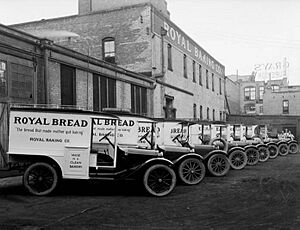
The Dodge Brothers Motor Company was officially started in 1913. By 1914, John and Horace introduced their first car, the four-cylinder Dodge Model 30-35 touring car. It was seen as a slightly fancier car than the very common Ford Model T. It had many new features that are common today, like all-steel bodies. Most cars back then still used wood frames under steel panels.
Other new features included 12-volt electrical systems (most cars had 6-volt systems until the 1950s). It also had a 35 horsepower engine, which was much more powerful than the Model T's 20 horsepower. The Dodge also used a modern sliding-gear transmission, while the Model T used an older design. John Dodge famously said, "Someday, people who own a Ford are going to want an automobile."
By 1916, Dodge Brothers cars were the second best-selling in the U.S. They were known for making high-quality parts for other car companies.
In 1916, Henry Ford stopped paying stock dividends to build his new River Rouge complex. The Dodge brothers sued to protect their annual dividends, which were about one million dollars. Ford ended up buying out his shareholders, and the Dodges were paid about $25 million. They had already earned almost $10 million in dividends, making their total profit over $34 million from their original $10,000 investment.
Also in 1916, Dodge Brothers vehicles became famous for being tough in military service. The U.S. Army used them in the Pancho Villa Expedition during the U.S. Mexico Border War. This was the first time the U.S. military used truck convoys. General "Blackjack" Pershing used 150 to 250 Dodge Brothers vehicles for the campaign in Mexico. Touring cars were used for staff and scouting. Pershing himself used a Dodge touring car to keep up with his army.
Later, about 12,800 Dodge cars and light trucks were used in World War I. Over 8,000 were touring cars, and 2,600 were commercial vehicles like trucks and vans. They mainly served as ambulances and repair trucks. Dodge remained the main supplier of light military vehicles for the U.S. until the Second World War.
Dodge brothers death and sale to Chrysler
Dodge Brothers cars were still the second best-selling in America in 1920. However, in January 1920, John Dodge passed away. His brother Horace then died in December of the same year. With both founders gone, their widows, Matilda Dodge Wilson and Anna Thompson Dodge, took over. They made Frederick Haynes, a long-time employee, the president.
During this time, the Model 30 was updated to become the Series 116. As the 1920s went on, Dodge slowly dropped in sales rankings, from third to seventh place in the U.S. market.
Dodge Brothers also made more types of trucks and became a top builder of light trucks. In 1921, Haynes signed a deal for Dodge's large dealer network to sell trucks with bodies made by Graham Brothers of Evansville, Indiana. From then on, Graham trucks used only Dodge-built parts.
Sales dropped, and Dodge Brothers fell to fifth place in the industry by 1925. That year, the widows sold the company to the investment group Dillon, Read & Co. for $146 million. This was the largest cash deal in history at the time.
Dillon, Read & Co. then sold stock in the new Dodge Brothers company, raising $160 million. Frederick Haynes stayed as the company head until E.G. Wilmer became chairman in November 1926. Wilmer was a banker with no car experience. Changes to the cars were small until 1927, when a new six-cylinder line was introduced.
On October 1, 1925, Dodge Brothers, Inc., bought 51% of Graham Brothers, Inc., for $13 million. They bought the rest in May 1926. The Graham brothers took over managing Dodge Brothers before leaving in early 1927 to start their own company, Graham-Paige.
By 1927, Dodge Brothers' sales had dropped to thirteenth place. Dillon, Read began looking for someone to buy the company. Dodge was sold to the new Chrysler Corporation in 1928 for $170 million. Chrysler wanted Dodge's factory and dealerships to better compete with Ford and Chevrolet. In just one year, Dodge jumped from thirteenth to seventh place in sales by 1928. On January 2, 1929, Chrysler announced that they were now building Dodge Brothers trucks.
Pre-war years
To fit into the Chrysler Corporation's car lineup, Dodge's models were reduced for early 1930. Prices for Dodge cars were just above DeSoto but less than the top-of-the-line Chrysler cars. (DeSoto and Dodge would switch places in the market for the 1933 model year, with Dodge becoming the brand between Plymouth and DeSoto.)
For 1930, Dodge added a new eight-cylinder car. This basic setup of a Six and Eight model continued until 1933. The cars slowly became more streamlined and longer, following the popular styles of the time. In 1932, Chrysler built a factory in Los Angeles, California. It built Chrysler, DeSoto, Dodge, and Plymouth vehicles until it closed in 1971.
The Dodge cars, along with most of Chrysler's vehicles, were redesigned in the "Wind Stream" look for 1935. This was a gentle form of streamlining. Sales jumped a lot compared to the previous year. Dodge did not use the very different Airflow styling that caused sales problems for Chryslers and DeSotos from 1934 to 1937. Dodge (and other Chrysler brands) added safety features. These included a smooth dashboard with no sticking-out knobs, curved door handles, and padded front-seat backs.
Another big redesign came for the 25th-anniversary 1939 models, which Dodge called the Luxury Liner series. These were completely new again for 1940, and then again in 1941, with a refresh for 1942. However, after the 1942 models came out, Japan's attack on Pearl Harbor forced Dodge to stop making passenger cars. They switched to making things for the war in February 1942. In 1941, Dodge cars introduced Fluid Drive. This feature helped prevent the car from stalling if the driver released the clutch too quickly.
World War II
Chrysler made a lot of war materials from 1942 to 1945. Dodge was especially known for its tough military light trucks and WC54 ambulances. Dodge America built over 400,000 trucks for the war. They were made in their new (1938) Warren truck plant in Michigan. Dodge mostly built light 4x4 trucks and light-medium 6x6 WC-series trucks. Chrysler Canada also made another 180,000 Dodge trucks for the British and Commonwealth militaries.
After the war, Dodge used the strong reputation of the WC-series trucks. They introduced a civilian version called the Power Wagon in 1945 for the 1946 model year.
Post-war years
Dodge started making civilian cars again by late 1945, for the 1946 model year. Because no new cars were made during the war, people were eager to buy any new car. Like most other carmakers, Dodge sold slightly updated versions of its 1942 design until 1948. These were six-cylinder models with two trim levels: basic Deluxe or fancier Custom. From 1949 to 1954, Fluid Drive could be combined with "Gyro-Matic," a semi-automatic transmission.
Dodge's car styling wasn't its strongest point at first. But it began to change by 1953, thanks to design chief Virgil Exner. The deluxe Coronet series, introduced in 1949, offered extra luxury. The Coronet Diplomat, Dodge's first hardtop coupe without a central pillar, was new for 1950. At the same time, Dodge also introduced its first V8 engine, the Red Ram Hemi. This was a smaller version of the famous Chrysler Hemi. The new 1953 car bodies were smaller and based on the Plymouth. Sales dropped in 1954 because the styling wasn't popular. In 1954, the fully automatic PowerFlite transmission was also introduced.
Chrysler borrowed $250 million in 1954 to expand and update its car designs. Exner led the creation of the new "Forward Look" styling for 1955. This started a new era for Dodge. With better styling and stronger engines each year until 1960, Dodge found many buyers. This improved even more when Dodge introduced a new line of cars called the Dart.
Special models were also sold, like the LaFemme (a white and orchid-colored car for women) and the Texan (a gold-accented Dodge sold in Texas). In 1957, a new automatic transmission, the three-speed TorqueFlite, was introduced. Both PowerFlite and TorqueFlite were controlled by push-buttons until 1965. In 1956, Dodge introduced the 4-door hardtop without a central pillar in all three Dodge series: Custom Royal, Royal, and Coronet. Dodge's pillarless models were all called "Lancer."
Dodge entered the compact car market in 1961 with the Lancer. This was a version of Plymouth's Valiant. It wasn't very successful at first. But its replacement, the 1963 Dart range, became one of Dodge's best-selling cars for many years.
Chrysler made a mistake by making the Dodge and Plymouth full-size cars smaller for 1962, which hurt sales. However, they fixed this in 1965 by turning those former full-size cars into "new" mid-size models. Dodge brought back the Coronet name and later added a sporty fastback version called the Charger. The Charger became very popular and won many races on the NASCAR circuit.
Full-size models changed slowly during this time. After Dodge dealers complained about not having a true full-size car in late 1961, the Custom 880 was quickly put into production. The Custom 880 used the 1962 Chrysler Newport body with the 1961 Dodge front end. The 880 continued until 1965, when a completely new full-size body was introduced. The Polara entered the medium price class, and the Monaco was added as the top series.
Dodge aimed for the muscle car market in the late 1960s and early 1970s. Along with the Charger, models like the Coronet R/T and Super Bee were available for buyers who wanted high performance. Dodge also entered the pony car market with the Challenger coupe and convertible for the 1970 model year. These cars could have powerful Hemi V8 engines.
To offer more types of cars in the 1970s, Dodge worked with Mitsubishi Motors. They sold Mitsubishi's small car as the Colt. It was designed to compete with cars like the AMC Gremlin and Ford Pinto. Chrysler would rely a lot on its relationship with Mitsubishi. At the same time, Dodge sold a version of the Plymouth Duster, called the Dodge Demon. It was cheap, but its engines weren't as fuel-efficient as the Colt's.
1973–1980
The 1973 oil crisis brought big changes for Dodge and Chrysler. Most of Dodge's cars, except for the Colt and some Dart models, were seen as using too much fuel. Chrysler didn't have enough money to quickly change its cars to fit the new market. While other carmakers made their big cars smaller, Chrysler was slow to adapt.
Chrysler used some of its other resources. They borrowed the recently introduced Chrysler Horizon from their European division. This allowed Dodge to quickly launch its new Omni subcompact car. At the same time, they brought in more models from their Japanese partner Mitsubishi, starting in 1971. This included a smaller Colt and a new Challenger (Dodge Challenger) in 1976.
For the 1975 model year, the Dodge Charger and Chrysler Cordoba shared the same new body. The Charger SE was the only model offered. It came with many engine choices, from a 318 cubic-inch V8 to a 400 cubic-inch V8.
1976 was the last year for the Dart in North America. Front disc brakes became standard. The Dart Sport 360 model was dropped, but a powerful 360 cubic-inch V8 engine was an option.
Dodge's replacement for the Dart was the Aspen, introduced in mid-1975 as a 1976 model. This new design was lighter, which helped with fuel economy. It also had more interior and trunk space than the Dart. Its boxy shape made it look like a bigger car. However, customers soon found problems with the Aspen, including rust and engine issues. These problems were mostly fixed later, but the last Aspens were the 1980 models.
1976 was the final model year for the Dodge Coronet name. Its body styles were limited to just a four-door wagon and a four-door sedan. The Coronet was replaced by the Diplomat for 1977, which was a fancier version of the Aspen.
Also, the full-size Dodge Monaco was renamed Dodge Royal Monaco for just one model year. After that, Dodge and Plymouth stopped making full-size models. The Monaco was replaced by the St. Regis for 1979.
The Aspen was praised for its styling and handling, but its build quality was poor. This hurt the car's reputation when sales were badly needed. It had problems with its carburetors, causing frequent stalling. The Aspen also had trouble starting, leading to several recalls.
The Dodge Magnum was introduced for 1978 to add to the Dodge Charger lineup. It was the last car to use the long-running Chrysler B platform. Its look was a more rounded Charger. It had four rectangular headlights hidden behind clear covers and optional T-bar or power sunroofs. The Magnum came with power steering, brakes, and seats.
The Omni and Horizon were very important because the company was close to bankruptcy. In 1978, Chrysler was the first American company to offer a front-wheel drive car to compete with the VW Rabbit. However, these cars didn't sell well at first. This added to Chrysler's money problems. But when the company asked for government help, the Omni showed they were trying to build small, fuel-efficient cars. For three years, the Omni/Horizon was Chrysler's best-selling model.
Things got very difficult in 1979. Chrysler's new chairman, Lee Iacocca, asked for and received federal loan guarantees from the United States Congress to save the company from bankruptcy. With the loan, Chrysler quickly started working on new car models.
The Dodge Mirada was a mid-sized, rear-wheel drive coupe made from 1980 to 1983. It shared its platform with the second-generation Chrysler Cordoba and the Imperial. About 53,000 Miradas were made. It was sold as a sporty personal luxury car with limited advertising because Chrysler was having serious money problems.
1981–1990
The first success from Chrysler's quick development program was the "K-Car". The Dodge version was the Dodge Aries. This strong and simple front-wheel drive platform led to many new Dodge models in the 1980s, including the revolutionary Dodge Caravan. Lee Iacocca and Hal Sperlich had the idea for this type of vehicle while working at Ford. Ford rejected the idea of a minivan in 1974. Iacocca then went to Chrysler, and together they created the T-115 minivan. This became the Caravan and Voyager, known as "Magic-wagons" in early ads. Chrysler introduced the Dodge Caravan and Plymouth Voyager in November 1983 for the 1984 model year. The Caravan not only helped save Chrysler but also created a whole new type of vehicle: the minivan.
By 1981, Chrysler was moving to smaller front-wheel drive designs. However, its older, larger rear-wheel drive Dodge Diplomat continued to sell. Diplomats made from mid-1988 until the end of production were among the first Chrysler cars to have a driver's side airbag as standard. As the 1980s went on, fewer private customers bought the Diplomat. It was eventually stopped during the 1989 model year.
Dodge would not sell another truly full-size car until the Monaco came out as a 1990 model.
The Daytona first used the 2.2 L Chrysler K engine in a normally aspirated (93 hp) or turbocharged (142 hp) version. A 100 hp 2.5 L K engine was added for 1986. In 1985, the 2.2 L Turbo I engine's horsepower increased to 146 hp. The 1984 Daytona was available in three versions: standard, Turbo, and Turbo Z. The Daytona Turbo was on Car and Driver magazine's 10Best list for 1984.
For 1987, the Daytona was restyled and had pop-up headlights. A new Shelby Z version was introduced with a more powerful 174 hp turbocharged 2.2 L engine. The Shelby Z also had many suspension upgrades and disc brakes on all four wheels. This version was sold in Europe as the Chrysler GS Turbo II. A more luxurious Pacifica version was also added.
The Dodge Dynasty was built on the Chrysler C platform in Belvidere, Illinois. It was related to the Chrysler New Yorker. Dynasty models included base and LE. A "Brougham" package was offered on 1992–93 LE models, adding a padded vinyl roof. The new electronically controlled four-speed automatic transmission, called the Ultradrive, debuted in 1989. It became the only transmission for V6 models until the Dynasty stopped production in 1993. Most Dynasties sold to private customers had V6 engines.
Through the late 1980s and 1990s, Dodge was known for sporty cars. This was supported by many high-performance and aggressively styled models, including the:
- Daytona
- 600
- Performance versions of the Lancer
- Viper
1990s
The Omni and Horizon stopped production in 1990. They were replaced by the Dodge Shadow/Plymouth Sundance, introduced in 1987. Both the Monaco and Premier were discontinued in 1992. However, the advanced factory and a key executive from American Motors led to the successful "cab-forward" LH cars. These included the Dodge Intrepid, Chrysler Concorde, and Eagle Vision.
The Dodge Spirit sedan was similar to the Ford Tempo and was also compared to the Ford Taurus, Honda Accord, and Toyota Camry. The Spirit sold well. Dodge-branded Mitsubishi vehicles were phased out by 1993, except for the Dodge Stealth, which ran until 1996. However, Mitsubishi-made engines and electrical parts were still used in many American Chrysler cars.
In 1992, Dodge greatly improved its performance focus with the Viper. It had an aluminum V10 engine and a sporty roadster body. This was the first step in "The New Dodge," an aggressive advertising campaign with many new models. TV ads, narrated by Edward Herrmann, highlighted the cars' new features and challenged competitors.
Later that year, the new Intrepid sedan was introduced. It was very different from its boxy Dynasty predecessor. The Intrepid used what Chrysler called "cab forward" styling. This meant the wheels were pushed to the corners of the car for maximum passenger space. The Intrepid came with driver and front passenger airbags, which was rare at the time. It also had air conditioning and a four-speed automatic transmission.
In 1994, the new second-generation Dodge Ram pickup truck was introduced. It had a bold new look that was very different from the boxy trucks made by other big car companies for two decades. The design had a big-rig-looking front end and a large grille. This was seen as risky at first but became very popular. The redesigned 1994 Ram sold very well and was named "Truck of the Year" by Motor Trend. Sales increased greatly. In 1996, it was a main vehicle in the movie Twister.
Dodge followed this idea on a smaller scale with the Neon and Stratus. The Dodge Stratus was the middle car of the Chrysler JA platform. The three cars (Stratus, Plymouth Breeze, and Chrysler Cirrus) looked very similar, only differing in the front, back, and wheels. The Stratus replaced the popular Spirit. The Stratus, Plymouth Breeze, and Chrysler Cirrus were all on Car and Driver magazine's Ten Best list for 1996 and 1997.
The Neon was sold as both a Dodge and a Plymouth in the U.S. and Canada. In Mexico, it was sold as Dodge and Chrysler. In Europe and Australia, it was sold as the Chrysler Neon. When the Neon was released, Chrysler Corporation president Bob Lutz said, "There's an old saying in Detroit: 'Good, fast, or cheap. Pick any two.' We refuse to accept that." The Japanese press even called the Neon the "Japanese car killer" because of its lower production cost. The Neon was praised for its looks, price, and power compared to other cars.
The Dodge Durango is a mid-size sport utility vehicle (SUV). The first two versions were based on the Dodge Dakota pickup truck and had a body-on-frame design. The Durango was sold as a tough, truck-based SUV that could hold up to seven passengers and tow heavy loads. It shared its front end and interior with the Dakota pickup. Early designs for the eight-passenger Durango had a third row that faced backward, like older station wagons. To make room for a more practical forward-facing third row, Dodge made the front doors shorter and raised the roof two inches behind the front seats.
The modern era: 1998–present
DaimlerChrysler and private ownership
In 1998, Chrysler Corporation merged with Daimler-Benz AG to form DaimlerChrysler. This merger aimed to simplify Chrysler's many car lines. Dodge's sister brand, Plymouth, was removed from the market. With this, Dodge became DaimlerChrysler's low-price and performance brand.
Updates to the Intrepid, Stratus, and Neon from 1998 to 2000 were mostly finished before Daimler's involvement. Dodge's first shared platform with the German side was the 2005 Magnum station wagon. This car replaced the Intrepid. It featured Chrysler's first main rear-wheel drive platform since the 1980s and brought back the Hemi V8 engine. The Charger was launched in 2006 on the same platform.
In 2000, the Stratus became the last of the "Cloud Cars" (a nickname for certain Chrysler models). The Cirrus was renamed Sebring, and the Breeze was discontinued.
This version of the Dodge Stratus was not sold in Canada. Sales declined as its ratings from car magazines fell. The Stratus was discontinued in May 2006.
The Dodge Avenger name returned in February 2007 as a 2008 model year sedan. It replaced the Dodge Stratus. The Avenger shared a platform with the redesigned Chrysler Sebring. The base engine was a 2.4 L four-cylinder "World Engine," a joint project between DaimlerChrysler, Mitsubishi, and Hyundai. Other engines included a 2.7 L V6 and a 3.5 L V6.
More cost savings came from sharing platforms with Mitsubishi. This led to the Caliber subcompact, which replaced the Neon, and the Avenger sedan. The rear-drive chassis was then used in early 2008 to build a new Challenger. Its styling looked like the original 1970 Challenger. Like its older version, the new Challenger coupe was available with a V8 engine. In Spring 2007, DaimlerChrysler sold its Chrysler Group to Cerberus Capital Management. Soon after, the housing market crashed, affecting the American car market. On May 1, 2009, Chrysler and GM filed for bankruptcy.
Fiat ownership
On June 10, 2009, Italian carmaker Fiat partnered with Chrysler under Sergio Marchionne. The UAW (United Auto Workers union) and the U.S. Government also joined. This formed Chrysler Group LLC, with Dodge still a part of it. The U.S. Government provided over $6 billion in loans to help. The company later fully repaid this loan with interest. This allowed Chrysler LLC to fully merge with Fiat to form FCA, Fiat Chrysler Automobiles, in 2014.
In 2013, Dodge brought back a compact car called the Dart, based on an Alfa Romeo design. It was the first new Dodge model made under FCA.
On May 6, 2014, FCA announced a big change. Dodge would focus only on performance vehicles. It would be placed between Chrysler (which would make mainstream cars) and a relaunched Alfa Romeo. As part of this change, Dodge would stop making the Dodge Grand Caravan and Dodge Avenger. The SRT division was also merged back into Dodge.
On July 8, 2020, FCA announced that Dodge would focus on three main performance models: Charger, Challenger, and Durango, starting with the 2021 model year. Both the Journey and Grand Caravan were discontinued after the 2020 models.
Dodge trucks
Over the years, Dodge became known for its passenger cars and many truck models. But after almost a century, a decision was made to create a separate truck brand called Ram. This was because their top-selling truck, the Dodge Ram, was so popular. Even though Ram trucks are sold separately from Dodge cars, Ram President Fred Diaz said:
Ram trucks will always be Dodges. Ram will always have the Dodge emblem inside and outside. We need to market them as Ram so Dodge can have a different brand identity: cool, young, and energetic. This won't fit the campaign for truck buyers. The two should have different themes.
Pickups and medium to heavy trucks
Since Dodge started building cars in 1914, they also offered light truck models. At first, these trucks were based on existing passenger cars. But eventually, they got their own designs as the market grew. In the 1930s and 1940s, Dodge offered light- and medium-duty trucks, then added a heavy-duty range. The very large, new Warren Truck Assembly plant was built in Michigan and opened in 1938. It has been producing Dodge trucks ever since.
In 1936, Dodge's light, car-based trucks were redesigned. They got a new "Fore-Point" design for the front and cab. More importantly, the old car frames were replaced with modern, truck-style chassis. These new frames were used on half-ton to one-ton trucks, moving Dodge into a heavier truck market.
In 1939, Dodge introduced a completely redesigned line of pickups and trucks. They had a new, 'art-deco' streamlined look. Dodge introduced the idea of "Job-Rated" trucks, trying to offer customers the perfect truck for every job. From 1939 onwards, Dodge's light and medium trucks were built in its 'Mound Road" plant in Warren, Michigan.
After World War II, Dodge introduced a civilian version of its successful four-wheel drive military trucks. It was called the Power Wagon. At first, it looked almost exactly like the military version. Later, other standard trucks were given 4WD and the "Power Wagon" name.
Dodge was one of the first to add car-like features to its trucks. They added the luxurious Adventurer package in the 1960s. They also offered sedan-like space in their Club Cab bodies in the 1970s. Due to falling sales and more competition in the 1970s, the company eventually stopped making its medium- and heavy-duty trucks.
Dodge introduced what they called the "Adult Toys" line to boost truck sales in the late 1970s. This started with the special edition Lil' Red Express pickup. It had a powerful police interceptor engine and visible big rig-style exhaust stacks. Later came the more widely available Warlock. Other "Adult Toys" included the "Macho Power Wagon" and "Street Van."
As commercial vehicle sales declined in the 1970s, Dodge stopped making its LCF Series heavy-duty trucks in 1975. The Bighorn and medium-duty D-Series trucks were also dropped. However, Dodge made thousands of pickups for the U.S. Military under the CUCV program from the late 1970s to the early 1980s.
Continuing money problems meant that even Dodge's light-duty models – renamed as the Ram Pickup line for 1981 – were only minimally updated until 1993. Two things helped Dodge's success during this time. One was the introduction of Cummins' powerful and reliable B Series turbo-diesel engine as an option for 1989. This made Dodge popular with customers who needed power for towing. The second was a V8 engine option for the mid-sized Dakota pickup, which was unique in its class.
Dodge introduced the Ram's all-new "big-rig" styling for 1994. Besides its bold look, the new truck became famous from its use on the TV show Walker, Texas Ranger starring Chuck Norris. The new Ram also had a new interior with a large console box and easy-to-use controls. A V10 engine, similar to the one in the Viper sports car, was also new. The smaller Dakota was redesigned for 1997 with the "big-rig" styling.
The Ram was redesigned again for 2002, and the Dakota in 2005. They were evolutions of the original design, adding the Hemi V8 engine option. New medium-duty chassis-cab models were introduced for 2007 with standard Cummins turbodiesel power.
For a while in the 1980s, Dodge imported small pickups from Mitsubishi, known as the D50 or later the Ram 50. These were a temporary solution until the Dakota's sales made them unnecessary. More recently, Mitsubishi has bought Dakota pickups from Dodge and restyled them into their own Raider line for sale in North America.
Vans
Dodge built panel delivery models for many years. Their first purpose-built van, the compact A Series, arrived for the 1964 model year. It was based on the Dodge Dart platform and used its proven six-cylinder or V8 engines. The A-series competed well with rivals from Ford and Chevrolet, and the small Volkswagen Transporter line.
As the market changed, Dodge realized a bigger and stronger van line was needed. The B Series was introduced for 1971. It offered car-like comfort in its Sportsman passenger line or large space for cargo in its Tradesman line. A chassis cab version was also offered for larger cargo boxes. Like the trucks, Chrysler's money problems in the late 1970s meant few major updates for the vans for many years. Renamed as the Ram Van and Ram Wagon for 1981, this old design continued for 33 years with only small updates until 2003.

The DaimlerChrysler merger in 1998 allowed Dodge to explore new ideas. The European-styled Mercedes-Benz Sprinter vans were brought over and given a Dodge look. Redesigned for 2006 as a 2007 model, the fuel-efficient diesel-powered Sprinters became very popular for city use among delivery companies like FedEx and UPS.
Dodge also offered a cargo version of its best-selling Caravan for many years. At first, it was called the Mini Ram Van, and later the Caravan C/V (for Cargo Van). For the 2012 model year, the Caravan C/V was rebranded as a Ram and renamed the Ram C/V.
The Grand Caravan became Dodge's last minivan. It was discontinued after the 2020 model year.
Sport utility vehicles
Dodge's first attempts at something like a sport utility vehicle appeared in the late 1950s. They had a windowed version of their standard panel truck, known as the Town Wagon. These were built in the same style until the mid-1960s.
But Dodge didn't seriously enter the SUV market until 1974 with the specially built Ramcharger. It offered the popular open body style and Dodge's powerful V8 engines. The Ramcharger competed strongly with trucks like the Ford Bronco, Chevrolet Blazer, and International Harvester Scout II.
Dodge was left with older products in the 1980s as the market changed. The Ramcharger continued until 1993 with only small updates. When the Ram truck was redesigned for 1994, the Ramcharger was discontinued in the American and Canadian markets. A version with the updated styling was made for the Mexican Market but was never sold in the U.S. or Canada.
Using the mid-sized Dakota pickup's chassis, Dodge introduced the 1997 four-door Durango SUV. It had seating for eight people and was sized between smaller SUVs (like the Chevrolet Blazer) and larger models (like the Chevrolet Tahoe). The redesigned version for 2004 grew a little, becoming a full-size SUV. For 2011, a new Durango based on the Jeep Grand Cherokee was released. The 2011 Durango became slightly smaller, similar to the original model. With the Journey being discontinued in 2020, the Durango became the only SUV offered by Dodge.
Dodge also imported a version of Mitsubishi's popular Montero (Pajero in Japan) as the Raider from 1987 to 1989.
High-performance vehicles
From the early 2000s, Dodge's most powerful vehicles were sold under Street & Racing Technology (SRT) branding. These models often had high-performance V8 engines. Examples include the Dodge Challenger SRT (2008–current), Dodge Charger SRT (2006–current), Dodge Magnum SRT (2006–2008), and Dodge Durango SRT (2018-current). They also made the Dodge Neon SRT-4 (2003–2005), Dodge Caliber SRT-4 (2008–2009), Dodge Viper (1991–2010; 2012–2017), and Dodge Ram SRT-10 (2004–2006).
In 2015, FCA introduced the Hellcat. This was a 707 horsepower, supercharged 6.2 L Hemi V8 engine. In 2017, Dodge released the Dodge Challenger SRT Demon. It is powered by an 840 horsepower supercharged 6.2 L Hemi V8. It comes with a "Demon Toolbox" for drag racing, including special front tires. However, buyers only get 840 horsepower on race fuel. On regular gas, it produces 808 horsepower.
International markets
Argentina
Dodge cars and trucks first came to Argentina in the early 1900s as imports. In 1960, Dodge partnered with Fevre-Basset to make vehicles locally. The first vehicle made in Argentina was the D-100 "Sweptline" pickup. Between 1961 and 1980, many trucks were produced. Passenger cars were also made, including the Valiant I and II, and local versions of the 1966 Dodge Dart (called Valiant III and IV). In 1971, the Dodge 1500, a version of the Hillman Avenger from the United Kingdom, was introduced. In 1982, Dodge vehicle production stopped when the German company Volkswagen bought the Fevre factory.
In Argentina, the name "Polara" was used for a series of cars based on the fourth-generation North American Dodge Dart. These cars were made between 1968 and 1980 by Chrysler-Fevre Argentina S.A.
In 1993, Dodge began selling cars and pickups directly in Argentina again. Today, the Journey and the Ram are available to Argentine customers.
Asia
Dodge entered the Japanese market in mid-2007 and the Chinese market in late 2007. Soueast Motors of China assembled the Caravan for the Chinese market. Dodge sold its vehicles in South Korea in 2004, starting with the Dakota. Dodge vehicles are no longer sold in China, Japan, and South Korea. In the Philippines, Dodge vehicles have been sold by Auto Nation Group since the 2000s. Dodge vehicles are also sold in some Middle Eastern countries.
Australia
Vehicles were made in Australia under the Dodge name by Chrysler Australia from the 1950s to the 1970s.
Dodge re-entered the Australian market in 2006 with the Caliber. This was their first car offered since the AT4/D5N trucks in 1979. It was also the first Dodge passenger car sold in Australia since the Phoenix sedan was stopped in 1973. The second model introduced was the Nitro, followed by the Avenger and Journey. Dodge chose not to use all the available models and engines. However, diesel engines were introduced in all their cars. After the Global Financial Crisis, Chrysler introduced the updated Caliber and stopped importing the Avenger. By early 2012, no new cars were imported into Australia except for the updated 2012 Journey.
The Dodge name continued in Australia due to consistent sales of the Journey. However, the brand was discontinued in the Australian market after 2016.
The Dodge Kingsway was also assembled in India by Premier Automobiles until the late 1950s.
Brazil
In Brazil, Dodge cars were made between 1969 and 1981. Models included the Dart, Charger, Magnum, and LeBaron (all with the same 318 cid V8 engine). The compact 1800/Polara was based on the British Hillman Avenger. Volkswagen bought the manufacturer in 1981. In 1998, the Dakota pickup started production in a new plant in Campo Largo, Paraná. It was built there until 2001 with petrol and diesel engines. In 2010, Dodge began selling the imported Ram 2500 pickup. The model range was expanded with the Journey crossover for the 2009 model year. The brand stopped selling its last product, the Journey, in 2019.
Canada
In Canada, the Dodge car lineup began to be phased out along with the Plymouth line. In 1988, the Dodge Dynasty was sold in Canada as the Chrysler Dynasty at both Plymouth and Dodge dealers. Similarly, the new Dodge Intrepid, which replaced the Dynasty, was sold as the Chrysler Intrepid.
For 2000, the new Neon became the Chrysler Neon. The Chrysler Cirrus and Mitsubishi-built Dodge Avenger were dropped. Dodge trucks, which had been sold at Canadian Plymouth dealers since 1973, continued without change. All Plymouth-Chrysler and Dodge-Chrysler dealers became Chrysler-Dodge-Jeep dealers.
Diluting the Chrysler name did not go well in Canada, especially since the nameplate had been promoted as a luxury brand since the 1930s. For 2003, the updated Neon appeared in Canada as the Dodge SX 2.0. Since then, all new Dodge models have been sold in Canada under the Dodge name.
Europe
Dodge started assembling lorries (trucks) in the United Kingdom from imported parts in 1922. In 1933, it began to make a British chassis at its factory in Kew, using American engines and gearboxes.
- Right-hand drive Dodge trucks
During the Second World War, Dodge Kew was part of the London Aircraft Production Group. It built parts for Handley Page Halifax bombers. The trucks made before and during the war were replaced by the Dodge 100 "Kew" truck (1949–1957), nicknamed the "parrot nose." Later normal-control Dodges built at Kew were the 200 series (1957–1963) and the 400 series (1963–1965). The 400 series was a version of the American D series medium-duty trucks. Also built at Kew were the cab-over 300 series (1957–1965) and its successor, the 500 series/K-series (1964–1978) tilt-cab. In 1964, Chrysler bought its first share in the British Rootes Group. It was decided to move all truck production to Rootes' factory in Dunstable.
In some export markets, British-built Dodge trucks used the Fargo or DeSoto names. After Chrysler took over the Rootes Group, whose commercial vehicles were sold under the Commer and Karrier names, things became more complex. Some Dodge 500s were given Commer badges. The 100 series "Commando" light truck (1970–1989) was sold under all five names. In 1976, Chrysler Europe simplified its brands. After that, all British-built commercial vehicles were sold as Dodges or Karriers. This included the smaller Commer SpaceVan (1960–1983) and Commer Walk-Thru (1961–1979), which became Dodges in their final years.
American Chrysler Corporation cars, including some Dodge models, were assembled from CKD kits in various places in Europe until the 1970s. Sales were low because even "compact" American cars like the Dodge Dart used a lot of fuel by European standards. However, some countries encouraged local manufacturers to build CKD models under license. This included AMAG in Switzerland (building Chryslers and Dodges 1948–1972) and Barreiros in Spain (building Dodge Darts from 1965). By 1969, Chrysler had full control of Barreiros. From 1970, the Spanish-built Dart was replaced by the Barreiros/Dodge 3700, which was made until 1977.
After Chrysler Europe faced problems in 1977 and sold its assets to Peugeot, the van and truck range and factories were quickly passed to Renault Véhicules Industriels. Chrysler allowed the Dodge name to be used on Renault trucks sold in certain European markets, especially the United Kingdom. However, the only new model to carry the Dodge name was the Dodge 50 series (1979–1992). This truck was widely used in Britain by utility companies, the military, and as a minibus. After 1987, the Dodge name was dropped from the remaining models, which became Renaults.
Dodge vehicles did not return to Europe until the Neon was introduced, badged as a Chrysler, in the mid-1990s.
Chrysler brought the Dodge brand back to Europe on a large scale in 2006. The lineup included North American-built Caliber, Avenger, Viper SRT-10, Nitro, and Journey cars and SUVs. But this return was short-lived due to the Great Recession and Fiat's takeover of Chrysler. In 2010, the Dodge brand was pulled from the UK due to low sales. On June 1, 2011, it was dropped from the rest of Europe. All Dodge models were discontinued in Europe except the Dodge Journey, which became the Fiat Freemont. The Dodge brand was reintroduced to many European markets in 2019.
Mexico
In Mexico, the Hyundai Accent, Hyundai Atos, and Hyundai H100 were branded as "Dodge". They were called "Dodge Attitude", "Verna by Dodge", "Atos by Dodge", and "Dodge H100". These were sold at Chrysler/Dodge dealers in the 2000s and early 2010s. Dodge and Hyundai ended their partnership. Dodge then began to sell rebadged and reworked Fiats and Mitsubishi vehicles.
Logo evolution
- Star: The first Dodge logo was a circle with two Greek deltas forming a six-pointed star. An interlocked "DB" was in the center, and "Dodge Brothers Motor Vehicles" was written around the edge. Although it looked like the Star of David, the Dodge brothers were not Jewish; they were Methodists. The "Brothers" was dropped from the name for trucks in 1929 and cars in 1930, but the DB star stayed on cars until 1939.
- Ram: For 1932, Dodge cars used a leaping ram as the hood ornament. By 1951, only the ram's head with curving horns remained. The 1954 models were the last to use the ram's head until it returned in the 1980s. Dodge trucks also used the ram as a hood ornament from 1940 to 1950.
- Crest: In 1941, Dodge introduced a crest, said to be the Dodge family crest. It had four horizontal bars broken by one vertical bar with an "O" in the center. A knight's head was at the top. The head was dropped for 1955, but the emblem lasted until 1957. It reappeared on the 1976 Aspen and was used until 1981.
- Forward Look: Virgil Exner's new "Forward Look" design for Chrysler vehicles in 1955 was highlighted by a logo of the same name. It was used on all Chrysler Corporation vehicles. The Forward Look logo had two overlapping boomerang shapes, suggesting space age rocket motion. This logo was used in Dodge advertising and on car parts until September 1962.
- Fratzog: Dodge's logo from September 1962 to 1981 was a broken deltoid made of three arrow shapes forming a three-pointed star. One of its designers came up with the made-up name "Fratzog" for the logo, and it stuck. This logo was used on various badges and emblems on Dodge vehicles.
- Pentastar: From 1982 to 1995, Dodge used Chrysler's Pentastar logo on its cars and trucks. In ads, Dodge's Pentastar was red, while Chrysler-Plymouth's was blue.
- Ram's head: Dodge brought back the ram's head hood ornament on the new 1973 Dodge Bighorn heavy-duty trucks. The ram's head slowly started appearing on pickup trucks as Dodge began calling its trucks "Ram." The current ram's-head logo appeared in late 1992 on the 1993 Intrepid. It became the standard logo in 1996 for all vehicles except the Viper, which uses the Viper's Head.
- New logo: In 2010, when the Ram brand became separate, two new Dodge logos were shown. The first logo has the word "DODGE" with two red slanted stripes. It was first used for marketing, but Dodge put it on the grilles of 2012 models.
A second emblem was shown with the 2011 Durango. It used the same five-point shield shape as the old emblem, but the ram's head was replaced with a chrome cross, like the brand's famous cross-haired grille. This was only used on the steering wheel. In 2014, the cross logo on the Durango steering wheel was replaced by the word "DODGE." A changed version of the Ram's head logo is still used for the Ram brand, with "RAM" written below it.
- Dodge logo evolution
Slogans
- Dependability, The Dependables (1920s–1967)
- Join the Dodge Rebellion (1966-1967)
- Dodge Fever (1968–1969)
- You Could be Dodge Material (1970–1971)
- An American Revolution (1982–1989)
- The New Spirit of Dodge (1989)
- The Tough New Spirit of Dodge Truck (1989)
- The new Dodge (1992–2000)
- Dodge. Different. (2000–2001)
- Grab life by the horns (2001–2007, mainly for trucks)
- Grab Life (2007 – mid-June 2010, in Ram pickup truck ads)
- Never neutral (2010–present)
- Born Dodge (2014–present)
- Domestic. Not Domesticated (2016–present)
- Excess drives success (2021–present)
- Tear up the streets... not the planet (2021–present)
List of Dodge automobiles
Current models
| Model | Year |
|---|---|
| Attitude | 2006-present (Mexico only) |
| Charger | 1966–1978; 1983–87; 2006–present |
| Durango | 1998–2009; 2011–present |
| Hornet | 2022–present (U.S. and Canada only) |
| Journey | 2021–Present (Mexico only) |
Past models
| Model | Year |
|---|---|
| 50 series | 1979–1993 |
| 100 "Commando" | 1970–1980 |
| 100 "Kew" | 1949–1957 |
| 300 | 1957–1965 |
| 330 | 1963–1964 |
| 400 | 1982–1983 |
| 440 | 1962–1964 |
| 500 | 1964–unknown |
| 600 | 1983–1988 |
| A100 | 1964–1970 |
| Attitude | 2006 |
| Aries | 1981–1989 |
| Aspen | 1976–1980 |
| Avenger | 1995–2000; 2008–2014 |
| B Series | 1948–1953 |
| C Series | 1950–1960 |
| Caliber | 2006–2012 |
| Challenger (E-body) | 1970–1974 |
| Challenger | 1970–74; 1978–83; 2008–2023 |
| Challenger (Mitsubishi) | 1978–1983 |
| Charger (B-body) | 1966–1978 |
| Charger (L-body) | 1981–1987 |
| Colt | 1971–1994 |
| Crusader | 1951–1958 |
| Coronet | 1949–1959; 1965–1976 |
| Custom | 1946–1948 |
| Custom 880 | 1962–1965 |
| Custom Royal | 1955–1959 |
| D5/D6/D7 | 1937 |
| D8/D9/D10 | 1938 |
| D Series | 1961–1993 |
| Dakota | 1987–2011 |
| Dart (original) | 1960–1976 |
| Dart (PF) | 2013–2016 |
| Daytona | 1984–1993 |
| Deluxe | 1946–1948 |
| Diplomat | 1977–1989 |
| Dynasty | 1988–1993 |
| Fast Four | 1927–1928 |
| Grand Caravan | 1984–2020 |
| Intrepid | 1993–2004 |
| Journey | 2009–2020 |
| Kingsway | 1946–1959 |
| La Femme | 1955–1956 |
| Lancer | 1955–1959; 1961–1962; 1985–1989 |
| Magnum | 1978–1979; 2005–2008 |
| Matador | 1960 |
| Mayfair | 1953–1959 |
| Meadowbrook | 1949–1954 |
| Mirada | 1980–1983 |
| Monaco | 1965–1978; 1990–1992 |
| Nitro | 2006–2012 |
| Omni | 1978–1990 |
| Omni 024 | 1979–1982 |
| Omni (GLH) | 1984–1986 |
| Phoenix | 1960–1973 |
| Polara | 1960–1973 |
| Power Wagon | 1945–1980 |
| Raider | 1987–1989 |
| Ram 50 | 1979–1996 |
| Ram Pickup | 1981–2009 |
| Ram SRT 10 | 2004–2006 |
| Ram Van | 1971–2003 |
| Ramcharger | 1974–2001 |
| Rampage | 1982–1984 |
| Regent | 1951–1960 |
| Royal | 1954–1959 |
| Shadow | 1987–1994 |
| Sierra | 1955–1956 |
| Spirit | 1989–1995 |
| Sprinter | 2004–2009 |
| SRT-4 | 2003–2005 |
| St. Regis | 1979–1981 |
| Stealth | 1991–1996 |
| Stratus | 1995–2006 |
| Town Panel / Wagon | 1954–1966 |
| Travco | 1964–late 1980s |
| Victory | 1928–1929 |
| Viscount | 1959 |
| Vision | 2015–2019 |
| Viper | 1992–2010; 2012–2017 |
| Wayfarer | 1949–1952 |
| WC series | 1940–1945 |
|
See also
 In Spanish: Dodge para niños
In Spanish: Dodge para niños
- DeSoto (automobile)
- Plymouth (automobile)
- Rootes Group for the historic Dodge of the UK
- Fargo (truck)
- List of automobile manufacturers of the United States
- List of Dodge automobiles for all production cars and trucks
- List of Dodge concept vehicles
- Ram Trucks
- Dodge Airflow truck
- Barreiros (manufacturer)





